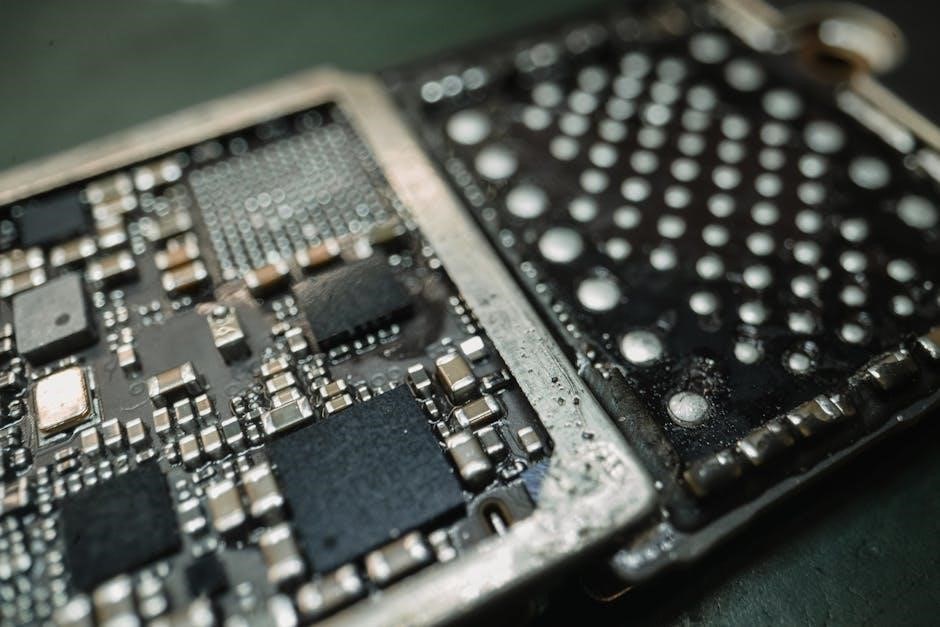Electrical and electronic symbols are essential for designing and interpreting circuit diagrams; This guide covers resistors, capacitors, transformers, diodes, switches, connectors, lighting controls, fire alarms, and cable trays, providing a clear reference for engineers and students.
Importance of Electrical and Electronic Symbols
Electrical and electronic symbols are fundamental for clear communication in circuit design. They provide uniformity and consistency, ensuring all engineers interpret diagrams identically. Symbols simplify complex circuits, enhancing readability and efficiency. They enable quick identification of components like resistors, capacitors, and transformers, fostering collaboration across regions and languages. Standardized symbols also support safety by facilitating rapid troubleshooting. This universal language is indispensable for education, training, and professional practice, making circuit design accessible and precise for everyone involved in electronics and electrical engineering.
Overview of Common Symbols in Electronics
In electronics, common symbols represent components like resistors, capacitors, inductors, transformers, and diodes. These symbols are standardized for universal understanding. Resistors are shown as zigzag lines, while capacitors appear as parallel lines. Inductors are coils, and transformers include two coils with a core. Diodes have an arrow indicating direction. Switches, connectors, and wiring are also standardized. These symbols simplify circuit design and troubleshooting, making it easier for engineers and technicians to communicate ideas effectively. Understanding these symbols is crucial for interpreting and creating circuit diagrams accurately;
Why Use a PDF Guide for Symbols?
A PDF guide for electrical and electronic symbols offers a comprehensive, portable, and easily accessible resource. It provides clear visuals and detailed explanations of various components, such as resistors, capacitors, and transformers. PDF guides are ideal for students, engineers, and technicians, as they can be viewed on multiple devices without losing quality. They also serve as a quick reference for designing, troubleshooting, and understanding circuit diagrams. Using a PDF guide ensures consistency and accuracy in symbol recognition, which is critical for efficient and safe electrical and electronic work.

Resistor Symbols
Resistor symbols represent components that reduce current flow. Common types include fixed, variable (potentiometer), photoresistor, rheostat, and tapped resistors, each serving specific circuit functions.
Fixed Resistor Symbols
Fixed resistor symbols represent components with constant resistance values. They are universally recognized in circuit diagrams and are essential for voltage division and current limiting. Fixed resistors are commonly used in power supplies, signal processing, and filtering applications. Their symbols vary slightly depending on the resistor type, such as thin-film or carbon film, but the standard fixed resistor symbol is a rectangular box with two terminals. This symbol is widely used in electrical and electronic schematics to indicate resistance in a circuit without variable adjustments.
Variable Resistor (Potentiometer) Symbols
A variable resistor, commonly known as a potentiometer, allows for adjustable resistance values. Its symbol features a standard resistor shape with an arrow or a sliding contact, indicating variability. Potentiometers are widely used for voltage regulation, signal level adjustment, and gain control in circuits. They are essential in audio equipment, voltage regulators, and various control systems. The symbol’s design clearly represents the component’s ability to vary resistance, making it easily identifiable in circuit diagrams. This adjustability is crucial in applications requiring precise control over electrical signals.
Specialized Resistor Symbols (e.g., Photoresistor)
Specialized resistors, such as photoresistors, have unique symbols to represent their specific functions. A photoresistor, or light-dependent resistor (LDR), changes resistance based on light exposure. Its symbol resembles a standard resistor with an arc or zigzag lines above it, indicating light sensitivity. These components are widely used in light-sensitive circuits, such as automatic lighting controls, camera light meters, and optical devices. Their symbols are essential for clear representation in circuit diagrams, enabling engineers to easily identify and utilize these components in designs requiring light-dependent functionality.

Capacitor Symbols
Capacitor symbols represent components that store electrical energy. Fixed and polarized capacitors have distinct symbols, with lines indicating plates and polarity for clear circuit representation.
Fixed Capacitor Symbols
Fixed capacitor symbols are used to represent capacitors with a constant capacitance value in circuit diagrams. These symbols consist of two parallel rectangular plates separated by a dielectric material, often represented by spaced lines between the plates. The fixed capacitor symbol is straightforward, with no additional markings indicating variability. They are commonly used in applications requiring stable capacitance, such as filtering, coupling, and tuning circuits. Understanding these symbols is crucial for engineers and students, as they appear frequently in both electrical and electronic designs. A PDF guide provides clear visuals and descriptions for easy identification and application;
Variable Capacitor Symbols
Variable capacitor symbols represent components with adjustable capacitance, essential in tuning circuits. The symbol resembles a fixed capacitor but includes an arrow or curved line, indicating variability. These capacitors allow for capacitance adjustment, commonly used in radio tuning and frequency applications. The symbol’s design highlights the ability to change capacitance, distinguishing it from fixed capacitors. Engineers and students often reference these symbols in circuit diagrams for precise component identification. A PDF guide provides detailed illustrations, ensuring accurate recognition and application of variable capacitors in electronic designs.
Polarized Capacitor Symbols
Polarized capacitor symbols are used to denote capacitors with a fixed positive and negative terminal. These capacitors are polarity-sensitive and must be installed correctly to avoid damage. The symbol typically features a curved line on one side, representing the cathode, and straight lines on the other, indicating the anode. Polarized capacitors are commonly used in power supplies, audio equipment, and electronic filters. Proper identification is crucial, as reversing the polarity can lead to component failure. A PDF guide provides clear visuals to help engineers and students accurately interpret these symbols in circuit diagrams.
Inductor Symbols
Inductor symbols represent components that store energy in a magnetic field. The basic symbol is a coil, with variations indicating fixed or variable inductance. A PDF guide helps identify these symbols accurately in circuit diagrams, essential for engineers and students.
Fixed Inductor Symbols
A fixed inductor symbol is represented by a coil of wire, typically with two terminals. It is used to store energy in a magnetic field. The standard symbol is universally recognized in circuit diagrams. Fixed inductors have a set value, making them essential for specific applications. They are commonly used in filters, tuning circuits, and impedance matching; The PDF guide provides detailed illustrations of fixed inductor symbols, ensuring clarity for engineers and students. Proper identification of these symbols is crucial for accurate circuit design and troubleshooting.
Variable Inductor Symbols
A variable inductor symbol resembles a fixed inductor but includes an adjustable component, often shown as a arrow or a variable resistor within the coil. This indicates that the inductance value can be changed, typically by adjusting the number of turns or the core material. Variable inductors are commonly used in tuning circuits, filters, and impedance matching applications. The PDF guide provides clear illustrations of variable inductor symbols, highlighting their unique features. Understanding these symbols is essential for designing and analyzing circuits with adjustable inductance requirements.

Transformer Symbols
Transformer symbols depict two coils (primary and secondary) wound around a common core. The core is often represented by parallel lines or a rectangular shape. Variations include center taps or multiple windings. These symbols are essential for circuit diagrams. A PDF guide standardizes these representations, ensuring clarity and consistency in electrical designs.
Step-Up and Step-Down Transformers
Step-up and step-down transformers are represented by symbols showing two separate coils on a shared core. Step-up transformers increase voltage, while step-down transformers reduce it. The symbol often includes arrows or markings to indicate voltage transformation. In circuit diagrams, the configuration of the coils and core helps differentiate between step-up and step-down types. A PDF guide provides standardized symbols, ensuring engineers and technicians interpret these components correctly. This consistency is crucial for designing and troubleshooting power systems efficiently.
Autotransformers
Autotransformers are represented by a single coil with a common winding and tap points. The symbol shows a transformer core with one winding and connections at specific points along it. Autotransformers are used to adjust voltage levels within a circuit. They are efficient and compact but lack isolation between primary and secondary circuits. The PDF guide provides clear symbols for autotransformers, ensuring accurate identification. This is crucial for engineers to design and troubleshoot systems effectively. The symbols highlight the transformer’s unique configuration and functionality in power systems.

Diode Symbols
Diode symbols consist of a triangle pointing towards a line, indicating one-way current flow. The standard symbol is modified for specific types like Zener or LEDs. Using a PDF guide ensures accurate representation and simplifies circuit design and interpretation for engineers and students alike.
Rectifier Diodes
Rectifier diodes are essential for converting AC to DC power in circuits. Their symbol resembles a standard diode, often with no additional modifications. These diodes are designed for high current and voltage ratings, making them ideal for power supplies and rectification applications. The PDF guide provides clear visuals and details about their ratings and usage, ensuring accurate implementation. By understanding rectifier diode symbols, engineers can efficiently design and troubleshoot power conversion circuits, emphasizing their role in modern electronics. Proper representation in a PDF guide ensures consistency and clarity for designers and students alike.
Zener Diodes
Zener diodes are specialized diodes designed to operate in reverse bias, maintaining a constant voltage across their terminals. Their symbol includes a diagonal line in the triangle, indicating their unique properties. Used for voltage regulation and surge protection, Zener diodes are crucial in circuits requiring stable voltage levels. The PDF guide provides detailed symbols and specifications, ensuring engineers can identify and implement them correctly. Understanding Zener diode symbols aids in designing reliable voltage-regulating circuits, making them indispensable in modern electronics. The guide’s clear visuals simplify their application in various electrical systems.
Light-Emitting Diodes (LEDs)
Light-Emitting Diodes (LEDs) are semiconductor devices that emit light when an electric current passes through them. Their symbol features an arrow pointing toward a vertical line, representing light emission. LEDs are widely used for indicators, lighting, and displays due to their high efficiency and long lifespan. The PDF guide includes detailed LED symbols, highlighting their polarity and connections. Engineers use these symbols to design energy-efficient circuits. LEDs are versatile, ranging from simple indicators to complex display systems, making them a cornerstone in modern electronics. The guide simplifies their representation for accurate circuit design and implementation.

Switch Symbols
Switch symbols represent different switch types, such as SPST, SPDT, and DPST, essential for circuit diagrams to ensure clarity and accurate circuit design and troubleshooting.
SPST (Single Pole Single Throw) Switches
SPST switches are the simplest type of switch, controlling a single circuit with two terminals: one input and one output. They either connect or disconnect the circuit, allowing or interrupting current flow. In the “on” position, the switch closes the circuit, enabling power to flow. In the “off” position, it breaks the connection, stopping current. SPST switches are commonly used in lighting circuits and basic electronic devices. Their straightforward operation makes them reliable and widely used in various applications. The SPST symbol in circuit diagrams clearly represents this functionality, ensuring easy identification and design.
SPDT (Single Pole Double Throw) Switches
SPDT switches are versatile components that control a single circuit but offer two possible outcomes. They feature three terminals: a common terminal, a normally open (NO) terminal, and a normally closed (NC) terminal. In their resting state, the common terminal connects to NC, and when activated, it switches to NO. SPDT switches are ideal for applications requiring a choice between two power sources or circuits. They are widely used in lighting systems, motor controls, and electronic devices, providing flexibility in circuit design and operation. Their symbol in circuit diagrams reflects this dual functionality, making them easily identifiable.
DPST and DPDT Switches
DPST (Double Pole Single Throw) and DPDT (Double Pole Double Throw) switches are advanced control devices that manage multiple circuits simultaneously. A DPST switch can activate or deactivate two independent circuits at the same time, offering synchronized control. DPDT switches, on the other hand, provide even greater flexibility by allowing each pole to connect to one of two possible positions, enabling complex switching operations. Both types are widely used in industrial and residential applications for controlling motors, lighting systems, and other high-power devices. Their symbols in circuit diagrams clearly depict their dual-pole functionality, ensuring precise representation in electrical designs.

Connector Symbols
Connector symbols represent plugs, sockets, and terminals in electrical circuits, ensuring proper connections between devices. They prevent wiring errors and ensure safety and reliability in circuit design.
Audio Jacks and Plugs
Audio jacks and plugs are essential connectors for transmitting audio signals. Commonly represented by symbols like the TRS (Tip-Ring-Sleeve) and RCA connectors, they ensure compatibility between devices. These symbols help in identifying the type of audio connection needed, such as mono or stereo, and their configurations. Widely used in headphones, speakers, and microphones, audio jacks and plugs are standardized for clarity in circuit diagrams. Their representation in PDF guides simplifies the design and troubleshooting of audio systems, ensuring proper signal transmission and minimizing wiring errors.
Power Connectors
Power connectors are critical for supplying power to electronic devices. Common symbols include DC power jacks, barrel connectors, and AC plugs. These symbols are universally recognized, ensuring safe and compatible connections. They are used in a wide range of applications, from small electronics to industrial machinery. The representation of power connectors in circuit diagrams helps engineers and technicians identify the correct voltage and current requirements. PDF guides provide clear visuals of these symbols, enabling easy identification and proper implementation in system design and troubleshooting.
USB and Data Connectors
USB and data connectors are essential for transferring data and power between devices. Common symbols include USB-A, USB-B, USB-C, and HDMI ports. These connectors are widely used in modern electronics for communication and charging. Standardized symbols ensure clarity in circuit diagrams, making it easier to identify ports and their functions. PDF guides provide detailed illustrations of these symbols, aiding in accurate wiring and connectivity. Proper use of these symbols ensures compatibility and efficient data transfer in electronic systems.

Lighting Control Symbols
Lighting control symbols represent switches, dimmers, and timers used in electrical circuits. These symbols ensure clear communication in circuit diagrams for efficient lighting system design and installation.
On/Off Switches
On/Off switches are fundamental components in electrical circuits, represented by simple symbols. These switches control the flow of electrical current, either allowing or interrupting it. Their symbols typically consist of a rectangle with two terminals, indicating the switch’s state (on or off). On/Off switches are essential for lighting control, enabling users to turn devices on or off effortlessly. In circuit diagrams, these symbols are universally recognized, making it easy for technicians to understand and implement lighting systems. Their simplicity ensures reliable operation in various applications, from household lighting to industrial systems.
Dimmer Switches
Dimmer switches are represented by unique symbols in electrical diagrams, indicating their role in controlling light intensity. Unlike on/off switches, dimmer symbols often include a diagonal line or arrow, signifying variable resistance. These switches adjust the voltage supplied to lighting fixtures, enabling brightness control. Their symbols are crucial for understanding lighting circuit configurations. In PDF guides, dimmer symbols are clearly illustrated, helping engineers and students design and interpret lighting systems effectively. This visual representation ensures precise control and safe installation of dimming systems in various applications.

Fire Alarm System Symbols
Fire alarm system symbols are essential in electrical diagrams, representing detectors, alarms, and control panels. They ensure safety, compliance, and proper system installation and maintenance.
Smoke Detectors
Smoke detectors are critical components in fire alarm systems, detecting smoke particles in the air to trigger alarms. Their symbols in electrical diagrams are typically represented by a rectangle or circle with a wavy line, indicating smoke detection; These symbols are standardized to ensure universal recognition, helping technicians and installers understand system layouts. Proper placement and wiring of smoke detectors are vital for reliable operation. Understanding these symbols is essential for designing and maintaining fire safety systems, ensuring timely alerts during potential fires.
Heat Detectors
Heat detectors are devices designed to detect temperature changes or excessive heat, often used in fire alarm systems. They are represented in electrical diagrams with specific symbols, typically a circle or square with wavy lines or a thermometer-like icon. These symbols indicate the presence of heat-sensing components. Understanding these symbols is crucial for installing and maintaining fire safety systems. Heat detectors are essential for early fire detection, especially in areas where smoke detectors may not be effective. Their standardized symbols ensure clarity and consistency in system designs.
Manual Call Points
Manual Call Points (MCPs) are devices used to manually trigger a fire alarm in case of an emergency. Their symbol in electrical diagrams is typically a rectangle with a push button or lever inside. These symbols are standardized to ensure easy identification. MCPs are strategically placed in buildings for quick access, enabling rapid response to potential fires. They are essential components of fire safety systems, providing a reliable way to alert others. Understanding their symbols is crucial for proper system installation and maintenance, ensuring safety and compliance with regulations.

Cable Tray and Related Items
Cable trays and related items are essential for organizing and supporting cables in electrical systems. They ensure safety, efficiency, and compliance with standards. Proper installation is crucial.
Cable Tray Symbols
Cable tray symbols represent the pathways and supports for cables in electrical systems. These symbols are used in diagrams to illustrate how cables are routed and secured. They include representations for straight sections, bends, and transitions. Standardized symbols ensure clarity and consistency in designs. Different types of cable trays, such as ladder, basket, and channel trays, have distinct symbols. These symbols help in planning and installing cable management systems efficiently. Proper use of cable tray symbols ensures safe and organized cable routing, reducing the risk of damage and improving system reliability.
Basket Tray Symbols
Basket tray symbols depict wire mesh or perforated cable management systems. These symbols are used to show lightweight, flexible cable support structures. They often include representations for straight sections, bends, and connectors. Basket trays are ideal for installations requiring easy access and ventilation. Symbols differentiate them from solid-bottom trays, emphasizing their mesh design. They are commonly found in commercial and industrial electrical diagrams. Using standardized symbols ensures clear identification in plans, aiding in proper installation and maintenance. These symbols are essential for efficient cable routing in modern electrical systems.
Channel Tray Symbols
Channel tray symbols represent rigid, continuous support systems for cables. These symbols often show a solid bottom with sides, distinguishing them from basket trays. They are commonly used in industrial settings for heavy-duty applications. Channel trays provide excellent support and protection, especially in harsh environments. Symbols are designed to be easily recognizable, showing the tray’s profile and mounting details. They are essential in electrical diagrams for precise installation planning. Using standardized symbols ensures clarity and consistency in electrical system documentation. These symbols are a cornerstone in modern electrical and electronic design guides.
Understanding electrical and electronic symbols is crucial for efficient circuit design and troubleshooting. This guide provides a comprehensive overview, ensuring clarity and precision for engineers and technicians.
In electrical and electronic circuits, key symbols represent components like resistors, capacitors, inductors, transformers, and diodes. These symbols are essential for designing and troubleshooting circuits efficiently. Resistors are shown as zigzag lines, while capacitors are represented by parallel lines. Inductors use a coil shape, and transformers include two coils with a core. Diodes are depicted with an arrow pointing towards a line. Switches, connectors, and lighting controls also have distinct symbols. These standardized symbols ensure clarity and consistency across designs and documentation.
Benefits of Using a PDF Guide
A PDF guide for electrical and electronic symbols offers numerous benefits. It provides a portable, high-quality reference that can be accessed offline. Symbols are displayed with clarity, ensuring easy identification. PDF guides often include comprehensive libraries of standardized symbols, making them indispensable for engineers and students. They also allow for quick searches, enabling users to find specific symbols efficiently. Additionally, PDF guides are easily shareable and printable, making them a practical tool for learning and professional use. This format ensures consistency and accuracy in circuit design and interpretation.
